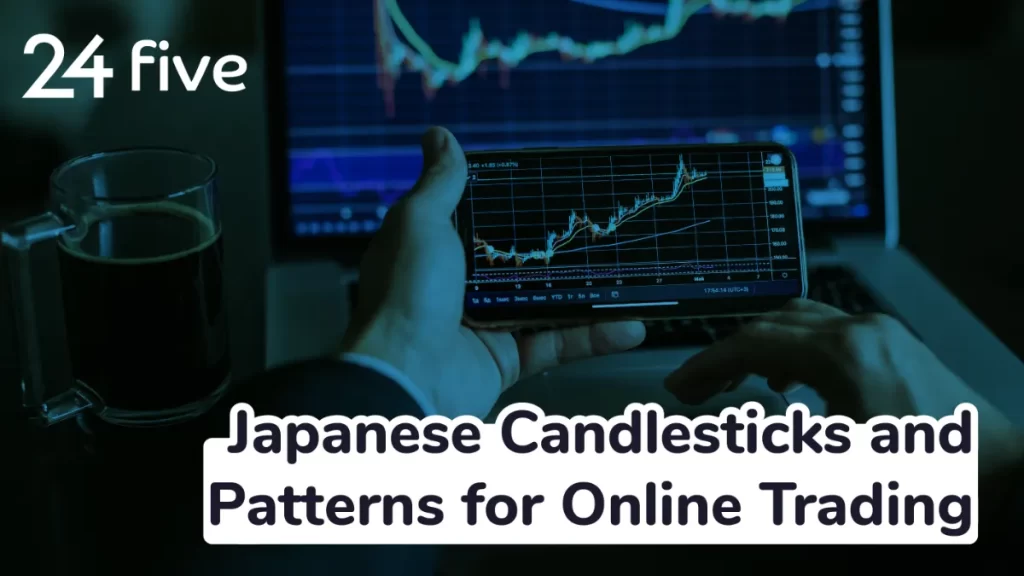Quick guide to learn how to invest with Japanese candles. Learn how to use candlestick patterns in your trading operations. What are they? and how to use them? We will tell you about it in the following article.
Definition
Japanese Candles, also known as candlesticks in English, are a way to graphically represent price movements in financial markets, such as stocks, currencies, commodities, among others. This analysis technique originated in Japan in the 18th century and was popularized by rice merchant Munehisa Homma.
Each candlestick displays information about the open, close, high and low price during a specific time period, such as 1 minute, 1 hour, 1 day, etc. The basic structure of a Japanese candlestick consists of two parts: the body and the shadows (or wicks).
Components of Japanese candles
Candlesticks consist of several components that provide information about the price action during a specific period. Here are the main components:
Candle Body
The body of the candle represents the difference between the opening price and the closing price during the selected time period. If the closing price is higher than the opening price, the body of the candle is usually green or white, indicating a bullish movement. If the closing price is lower than the opening price, the body is usually colored red or black, indicating a bearish movement.
Upper Shadow
The upper shadow extends from the closing price to the maximum price reached during the period. It represents the difference between the closing price and the maximum price.
Lower Shadow
The lower shadow extends from the opening price to the minimum price reached during the period. It represents the difference between the opening price and the minimum price.
These components combine to form the complete structure of a Japanese candlestick. On a chart, you will see several consecutive candlesticks showing price action over time. The different patterns and combinations present in the candles are used to perform technical analysis and make trading decisions. Analysts often pay attention to specific candlestick patterns to identify trends, changes in direction, and potential entry or exit points in the market.
Why identify patterns?
Entry and Exit Decisions: Candlestick patterns are often used to identify possible entry and exit points in a trade. For example, a bullish reversal pattern, such as a hammer, could indicate a possible trend reversal and be considered a buy signal.
Trend Identification: Candlestick analysis is useful in identifying the direction of the current market trend. Specific patterns, such as consecutive bullish candles, can indicate a bullish trend, while bearish patterns can signal a bearish trend.
Signal Confirmation: Traders often use candlestick patterns to confirm other technical analysis signals. For example, if a candlestick pattern suggests a trend change in the same direction as a signal from a technical indicator, this can strengthen confidence in the trading decision. Risk Management: Candlestick analysis can also help in risk management. By observing specific patterns, a trader can set stop-loss or take-profit levels, thus adjusting their risk exposure.
Identifying Support and Resistance: The bodies and shadows of candlesticks often interact with support and resistance levels on a chart. By identifying these levels along with candlestick patterns, traders can make informed decisions on order placement.
Identifying Support and Resistance: The bodies and shadows of candlesticks often interact with support and resistance levels on a chart. By identifying these levels along with candlestick patterns, traders can make informed decisions on order placement.
Interpretation of Japanese candles
Interpreting Japanese candles involves analyzing the information provided by the body, upper shadow, and lower shadow of each candle. Here are some key concepts to interpret Japanese candlesticks:
Candle Body
- Bullish Candle: If the body is colored green, or white or has no fill (depending on your chart settings), the closing price is higher than the opening price. This suggests bullish pressure and a possible increase in prices.
- Bearish Candle: If the body is colored red or black, it indicates that the closing price is lower than the opening price. This suggests bearish pressure and a possible decline in prices.
Upper and Lower Shadow
- The upper and lower shadows provide information about the volatility and extent of price movement during the period.
- Long Upper Shadow: It can indicate selling pressure during the session, even if the candle is bullish. Buyers tried to push prices higher, but sellers were successful at the end of the session.
- Long Lower Shadow: It can indicate buying pressure during the session, even if the candle is bearish. Sellers tried to lower prices, but buyers were successful at the end of the session.
Candle Patterns
- Interpretation becomes more complete when looking at candlestick patterns, which are specific combinations of candlesticks that provide signals about possible changes in market direction. Some examples include the “Hammer” (potential bullish reversal) and the “Shooting Star” (potential bearish reversal).
Market Context
- It is always essential to take into account the market context. Candlesticks should be evaluated in relation to the overall trend, support and resistance levels, and other technical and fundamental factors.
Confirmation with Other Indicators
- For greater confidence in candlestick signals, many traders confirm them with other technical indicators or fundamental analysis. The convergence of different signals can strengthen the validity of a trading decision.
- Remember that the interpretation of Japanese candles is a tool within technical analysis and does not guarantee specific results. It is important to combine this technique with other risk management methods and practices in your trading approach.
Measure Japanese candlesticks in PIPS
To understand this concept, we first invite you to read What is a PIP?
But in summary, PIPs are the smallest possible unit of change in the price of an asset.
To calculate PIPs with Japanese candles, you must subtract the opening price from the closing price for a bullish candle or vice versa for a bearish candle. Then, multiply the result by the value of one pip for the currency pair or financial instrument you are trading.
Example
If you are trading the EUR/USD pair and the bullish candle moves from 1.1200 to 1.1220, the length of the candle in pips would be 20 pips.
Remember that measuring candlesticks in pips can provide information about the volatility and strength of a price movement, but it is always important to take into account the market context and consider other factors before making trading decisions based solely on candle length. candles.
Most popular candle patterns
Candlestick patterns are valuable tools in technical analysis to help traders identify potential changes in market direction. Here I present eight of the most important Japanese candlestick patterns:
Hammer
It is a candle with a small body near the upper end of the price range and a long lower shadow. It is formed after a fall and suggests a possible bullish change in the trend.
Shooting Star
Similar to the hammer, but is formed after a rise. It has a small body near the low end of the price range and a long top shadow. Indicates a possible bearish reversal.
Engulfing
Characteristics: It is made up of two candles, where the second candle completely “engulfs” the body of the previous candle. A bullish engulfing indicates a possible bullish reversal, while a bearish engulfing suggests a possible bearish reversal.
Doji Star
It is formed when a candle with a small body follows a significantly larger candle. It indicates indecision in the market and can signal a possible trend reversal.
Three White Soldiers Pattern
It is made up of three consecutive bullish candles with increasingly larger bodies. It indicates strong bullish momentum and is considered a bullish trend reversal pattern.
Three Black Crows Pattern
Similar to the three white soldiers pattern, but it is bearish. It is made up of three consecutive bearish candles with increasingly larger bodies. It indicates strong bearish momentum and is considered a bearish trend reversal pattern.
Dark Cloud Cover
It is formed after an uptrend and consists of two candles: a bullish candle followed by a bearish candle that opens above the close of the bullish candle and closes at least halfway down its body. Indicates a possible bearish reversal.
Harami
It is made up of two candles, where the first has a large body and the second has a smaller body that is completely contained within the body of the first. It may indicate a trend reversal.
Pattern Validity
Determining the validity of a Japanese candlestick pattern involves considering several factors and confirming the signal with other indicators and elements of technical analysis. Here are some guidelines for evaluating the validity of a candlestick pattern:
Market Context
Examine the general context of the market. Is the pattern formed in a clear trend or in a sideways market? The validity of the pattern may depend on the market environment.
Trading Volume
Confirm the pattern signal by observing the trading volume. Stronger validation is usually supported by a significant increase in volume. An increase in volume indicates greater market interest and commitment.
Pattern Confirmation
Look for confirmation of other patterns or technical signals. For example, if you see a hammer at the bottom of a downtrend, look for additional signs of bullish reversal, such as divergences in momentum indicators.
Supports and Resistances
Examine the location of the pattern in relation to support and resistance levels. A pattern near a key level may carry more weight in terms of validity.
Time Frame
The validity of the pattern may vary depending on the time frame in which it is formed. A pattern on a longer time frame may have more relevance than on a shorter one.
Next Candle Patterns
Observe the price action after the pattern formation. Does the market confirm the direction suggested by the pattern or is there an opposite movement? The continuation of the pattern is essential for its validity.
Closing Confirmation
Wait for the candle to close to confirm the pattern. Sometimes the exact shape of the candle can change during the session, with the close providing stronger confirmation.
False Signals
Recognize that no pattern is infallible and that there may be false signals. Use additional tools to reduce the likelihood of falling into traps, such as using patterns along with trend and strength indicators.
By integrating these factors into your analysis, you will be able to make more informed decisions about the validity of a candlestick pattern. Remember that experience and practice also play a key role in developing your skills in interpreting these patterns.









